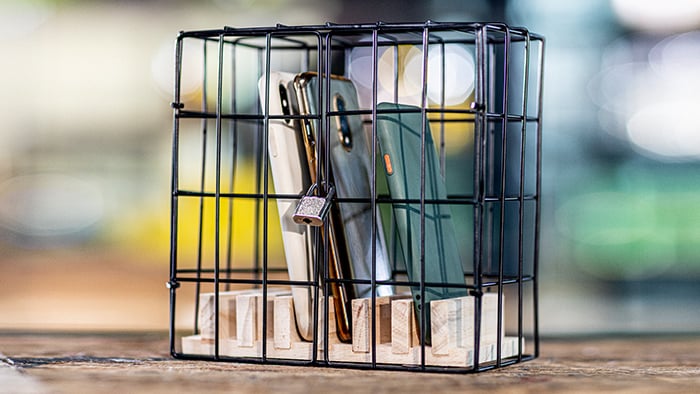- Security
- Privacy
- Performance
iPhones may have generous storage space, but if you download enough files and apps, you’ll get the dreaded “Storage almost full” message, signaling it’s time to finally clean up your iPhone. Read on to learn how to free up space on your iPhone. Then get a specialized iPhone cleanup app to help manage your storage and keep your phone running smoothly.

You can free up space on your iPhone by deleting unused or irrelevant photos, messages, apps, and other files that are clogging up your storage. Alternatively, if you want to preserve all your data, you can transfer media to another device or the cloud.
Here’s what you can do to clear iPhone storage:
If you want to free up space by deleting old iMessages in bulk, here's how you can do it efficiently:
Open Settings > Messages > Message History > Keep Messages.

Change the period from the default (Forever) to 30 Days or 1 Year. Then tap Delete when prompted.

From now on, all iMessages older than your cut-off point will be deleted, helping to prevent your storage from spiraling out of control again.
If you have an iPhone, you likely have iCloud, Apple’s cloud storage service. Syncing your files, photos, and backups to iCloud stores the data on their remote servers, keeping your iPhone’s storage clear while still allowing you to access your files across all your Apple devices.
Here’s how to sync to iCloud:
Go to Settings > Account > iCloud.

To ensure an app’s contents are being synced to iCloud, tap the app under Apps using iCloud (in this example, Photos).

Toggle on Sync this iPhone and make sure Optimize iPhone Storage is checked.

You can go through all your photo albums on your iPhone and delete the ones you don’t need, but all that tapping and deleting could take days. An easier way to delete old and unneeded photos is by permanently wiping those you’ve already deleted, but are stuck in “Recently Deleted” purgatory.
Here’s how to get rid of old photos you don’t need:
Go to Photos > Albums > Recently Deleted. You’ll need to enter your Passcode or TouchID to view this album.

Tap Select then Delete All at the bottom left of the screen, followed by Delete from All Devices to confirm.

Another solution for files you want to keep but that are taking up too much space on your iPhone is to transfer them to your iMac or MacBook. There are a couple of ways to do this: you can transfer files wirelessly via AirDrop, or you can transfer them the old-fashioned way via a cable connection.
Here’s how to transfer media to your Mac via AirDrop:
Ensure that Wi-Fi and Bluetooth are turned on on both devices. Then, select the file(s) you want to transfer and tap the Share icon.

Tap AirDrop, then select the user you want to share it with (your Mac). Then, manually delete the item from your iPhone to remove it from your device.

Here’s how to transfer media to your Mac through a cable connection:
Connect your iPhone to your Mac via a USB cable.
Open Finder on your Mac and select your iPhone.
Click Files in the button bar, which will show the apps on your iPhone that support file sharing, or use the Photos app if transferring photos or videos.
Click and drag files from your iPhone into a relevant folder on your Mac to transfer files from your iPhone to your Mac.
You can also clear other storage on your Mac to keep it fresh and clean. Take a deeper dive into our guide to cleaning up your Mac.
You can also clean up the apps you have on your iPhone by offloading data on unused apps or even deleting them altogether. Offloading apps that you use frequently but take up a lot of data, such as social media, streaming, navigation apps, and even mail, can also help free up space on your iPhone.
Offloading unused apps on your iPhone is easy. Go to Settings > General > iPhone Storage. If you’re low on space, your iPhone is likely already suggesting to offload unused apps. Simply tap Enable and your iPhone will clear this storage automatically.

To manually offload additional apps:
Navigate to iPhone Storage, scroll, select an app, and tap Offload App to remove it but retain related documents and data. Tap Offload App again to confirm.

Or, if you don’t think you’ll use the app again and don’t need to save the data, select Delete App (instead of Offload App), and tap Delete App again to confirm.
If you have Spotify, periodically clearing the app cache can help free up significant space on your iPhone. Here’s how to reclaim iPhone storage being used by Spotify temp files:
Open Spotify and tap Home.
Tap your profile, followed by Settings and privacy.
Select Storage, tap Clear cache, and confirm.
For photos you want to keep on your iPhone, install Avast Mobile Security for extra protection. Our dedicated mobile security and privacy app includes an encrypted photo vault, only accessible with your fingerprint, face scan, or passcode, so these photos remain only for you and those with whom you choose to share them.
You can free up space on your iPhone by clearing system data, which includes cached files from apps like Safari, temporary files from daily use, and certain system data like logs. While useful, this data can build up over time and take up significant space on your iPhone.
Here’s how to reduce the amount of system data stored on your device:
Restarting your iPhone refreshes the operating system, allowing it to rationalize system data and get rid of files it no longer needs. That’s why it’s good to restart it regularly.
Here’s how to restart your iPhone:
Hold the power and volume down buttons simultaneously, then slide to power off when the prompt appears on-screen.
Wait a minute, then press the power button again and wait for the Apple logo to appear on-screen.
Within a few moments, your iPhone should have rebooted, with less clutter in its storage.
Web browsers collect unnecessary data over time, so clearing cookies and caches on your iPhone will free up some space. Browsing in Safari’s incognito mode will also help to prevent cookie data from accumulating in the first place.
To clear your Safari cache, go to Settings > Safari > Clear History and Website Data > Clear History and Data.

When browsing on your iPhone, you want to make sure your personal data remains private and secure. While many consider iPhones to have more robust security compared to other smartphones, they’re far from invulnerable.
That’s where Avast Mobile Security comes in. As well as blocking viruses, malware, and other online threats, it can also scan Wi-Fi networks for vulnerabilities before you connect, and scan databases to alert you if someone leaked one of your passwords.
iPhone backups typically contain very large amounts of data, including app information, messages, photos, and settings. These backups are typically stored in iCloud or on a computer, but if saved locally on the device, they can consume valuable space. Effectively managing your iPhone backups can free up storage for other files, apps, or system processes, helping the device run more efficiently.
Backing up your iPhone and then resetting and restoring the device lets you wipe it completely and start again with a clean slate. This frees up storage space because it removes all user data and then reinstalls only essential data and apps, ditching unnecessary files, cached data, and other temporary storage.
You can back up your iPhone by ensuring that iCloud sync is turned On. Or follow these steps to back up to your Mac computer:
Connect your iPhone to your Mac with a cable, open Finder, and select your iPhone.
Click General > Back up all of the data on your iPhone to this Mac.
If you want to encrypt your data, you can select Encrypt local backup and set a decryption password.
Select Back up now — the process should only take a few minutes.
Then, follow the steps for resetting your iPhone and then restoring your iPhone from a backup.
Other data can also sneak into your iPhone without you realizing: downloaded files, both useful and junk, can quickly clutter your storage. You can delete this Other/System data stored on your phone by updating iOS, deleting downloaded videos and music, and deleting old podcasts, files, and documents.
Updating the OS on your iPhone can help free up storage by optimizing system files and occasionally reducing app sizes. And it’s often automatic, so whenever your iPhone announces an update you can just connect it to power and let the install happen.
To update your iOS manually:
Go to Settings > General > Software Update. If a new version is available, you should be able to see it on your screen.

Set Automatic Updates to On to ensure that future updates are automatic. Tap Download and Install, then enter your Passcode to confirm.

Using video apps like YouTube Premium or VLC Player to download, store, and play videos is a surefire way to quickly consume space on your iPhone. Even a few downloaded videos can take up significant storage due to their large file sizes.
To delete YouTube video files from your iPhone, open the YouTube app and navigate to Library > Downloads. Then tap Delete from downloads to remove the offline videos.
Downloaded music can also quickly take up a lot of space on your iPhone if you don’t trim your collection now and then. If you’ve downloaded music through Apple Music, you can delete any unwanted music files from your iPhone by following these steps:
Go to Settings > Music, scroll down to Downloaded Music, and tap Edit in the top right corner.

Tap the red minus (-) button next to All Songs to delete all downloaded music at once, or tap next to individual artists to delete music from specific artists. Finally, tap Delete to confirm.

If your podcast episode backlog is getting too big, your iPhone can help you manage storage by limiting downloads. In the Podcasts app settings, you can choose to automatically keep only the five most recent downloads per show.
You can also delete podcasts in the Podcasts app. Select an individual podcast, then tap Remove Downloads. This will remove all downloads for that specific podcast.
This can clear a ton of space on your iPhone — often several gigabytes at a time if you subscribe to a lot of podcasts.
Although less likely to yield such impressive results, you should also delete any documents or other files you don’t need anymore.
If you still can’t get your iPhone sufficiently decluttered after deleting excess data and syncing to iCloud storage to reduce the burden, a factory reset is a last resort. This deletes all of your user data and restores your iPhone to a clean, out-of-the-box configuration. Don’t forget to back up your iPhone first.
Here’s how to perform a factory reset:
Go to Settings > General > Transfer or Reset iPhone > Erase All Content and Settings.

Tap Continue and enter your passcode or Apple ID password to confirm.
With all content and settings reverted to factory settings, your iPhone should be a blank slate — good as new. Once the reset is complete, your iPhone will restart and display the Hello screen. You can then set up your iPhone as new or restore from a backup.
You can easily check if your iPhone storage is full or check how much space you have left by going to Settings > General > iPhone Storage. When your storage is filling up, you’ll get a “storage almost full” warning message, as well as some helpful suggestions on how to clean up your iPhone storage.
If you find that your iPhone storage is full or nearly full, cleaning up your iPhone will also help speed it up and restore some of its original performance.
If your iPhone storage is full despite having iCloud, several factors could be at play. You might not have iCloud storage optimization enabled, meaning files aren't being offloaded from your device. Or, especially if you're using the free iCloud plan, it could simply be full.
Check your iCloud account settings and ensure that iCloud is enabled on all the apps that take up the most space, like Photos. If necessary, consider getting a larger cloud storage subscription to take even more weight off your device storage.
Now that you’ve cleaned your iPhone from top to bottom, it’s time to get a dedicated cleanup and mobile utility app so you don’t have to run through all those steps again. Avast Cleanup was built by professional performance engineers who know how critical it is to keep mobile phones uncluttered and running smoothly. Install Avast Cleanup today to enjoy a faster, more responsive mobile experience.
Install free Avast Cleanup for Android to help speed up your phone, clean up clutter, and get more space.
Try Avast Cleanup for PC to help speed up your computer, clean up clutter, and get more space.
Get Avast Cleanup to help optimize your Mac, clean up clutter, and get more space.
Install free Avast Cleanup for iOS to help optimize your iPhone, clean up clutter, and get more space.












Supercharge your iPhone with Avast Cleanup
Avast Cleanup
Free installSupercharge your Android with Avast Cleanup
Avast Cleanup
Free install